Discovering Shaoshan: A Journey Through Mao Zedong’s Birthplace
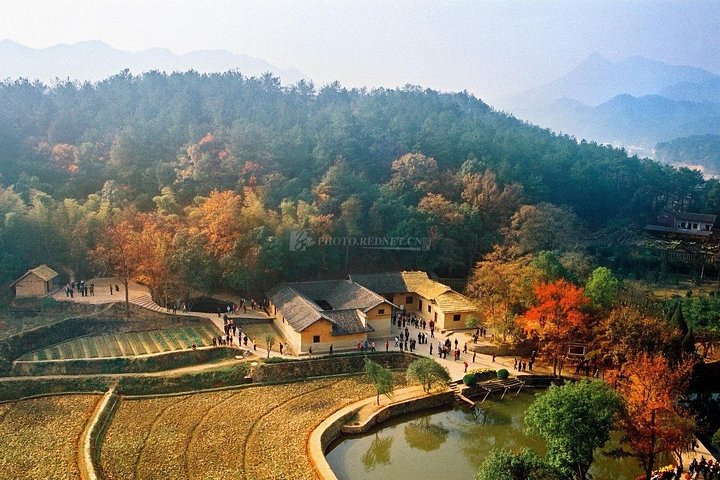
An Essential Guide to Visiting Shaoshan
In This Guide
- An Essential Guide to Visiting Shaoshan
- The Rich History and Legends of Shaoshan
- Main Highlights: What You Absolutely Can’t Miss
- Planning Your Visit: A Practical Guide
- Tickets: Prices, Booking, and Tips
- How to Get There: A Complete Transportation Guide
- Local Cuisine and Accommodation Nearby
- Frequently Asked Questions
- Final Thoughts on Your Trip
Nestled in the heart of Hunan province, Shaoshan is a destination that offers a unique blend of revolutionary history, cultural significance, and breathtaking natural beauty. This charming county-level city, a mere stone’s throw from Changsha, is best known as the birthplace of Chairman Mao Zedong, a pivotal figure in modern Chinese history. Visiting Shaoshan is not just an opportunity to walk in the footsteps of one of the most influential leaders of the 20th century; it is a chance to immerse yourself in the rich tapestry of China’s revolutionary narrative and explore the stunning landscapes that have inspired countless visitors.
Why You Should Visit Shaoshan
A Revolutionary Pilgrimage
Shaoshan is a revered site for those interested in China’s revolutionary past. The city is home to key historical landmarks, such as the Former Residence of Mao Zedong, where the young Mao spent his formative years, and the Mao Zedong Memorial Hall, which houses artifacts and exhibitions dedicated to his life and legacy. Each site is a window into the life of a leader who shaped the course of a nation.
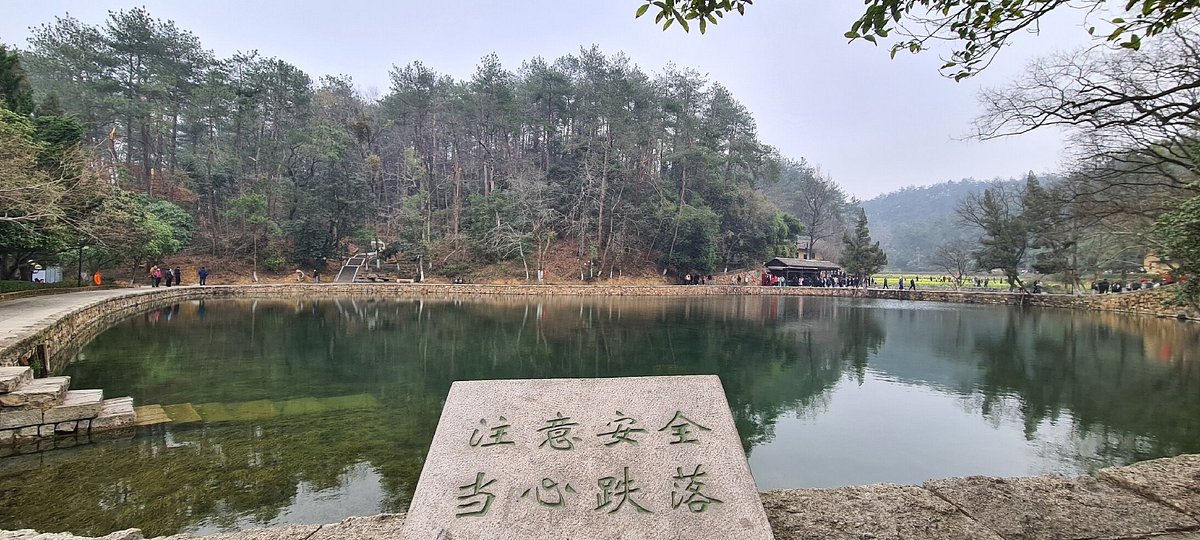
Shaoshan.
Cultural Richness
Beyond its revolutionary roots, Shaoshan is also closely associated with other significant figures in Chinese history, including military commander Peng Dehuai and renowned painter Qi Baishi. Visitors can delve into their stories by exploring their former residences and learning about their contributions to Chinese culture and society.
Nature’s Splendor
The natural scenery around Shaoshan is nothing short of spectacular. Surrounded by the majestic peaks of the Nanyue mountain range, the landscape features lush greenery, serene lakes, and picturesque parks. Yuhu Park, with its tranquil reservoir and vibrant flora, is an ideal spot for leisurely strolls, while hidden gems like the Water Dripping Cave and Shaoping Peak beckon adventurers seeking a taste of the region’s natural allure.
A Living Cultural Experience
A visit to Shaoshan is a journey through time, where you can encounter not only the historical relics but also the vibrant spirit of the locals. You may find veterans reminiscing about their experiences, families paying homage to their ancestors, and students exploring their heritage. The Bronze Statue Square and the Ancestral Hall of the Mao Family serve as focal points for gathering and reflection, where you can feel the pulse of modern Chinese culture intertwined with its storied past.

Shaoshan.
Planning Your Visit
To make the most of your trip to Shaoshan, consider tailoring your itinerary around its key attractions. Whether you are a history buff, a nature lover, or someone seeking to understand the essence of modern China, Shaoshan promises a rich and rewarding experience. With its captivating mix of history and natural beauty, this charming city invites you to explore, reflect, and appreciate the profound narratives that have shaped a nation.
The Rich History and Legends of Shaoshan
Nestled in the picturesque Hunan Province, Shaoshan is a place where history and culture intertwine, offering visitors a unique glimpse into the life and legacy of one of China’s most prominent figures—Mao Zedong. This vibrant locale is not just a memorial to revolutionary events but a treasure trove of rich narratives, profound traditions, and stunning landscapes.
The Birthplace of a Revolution
Shaoshan holds an indelible place in modern Chinese history as the birthplace of Mao Zedong, the founding father of the People’s Republic of China. Born in 1893 to a peasant family, Mao’s early life in Shaoshan was steeped in the struggles of rural life, which greatly influenced his political ideologies. The Former Residence of Mao Zedong, a humble structure built from mud and brick, still stands as a testament to his origins. Visitors can walk through the very rooms where Mao grew up, gaining insight into the formative experiences that shaped his revolutionary spirit.

Shaoshan.
A Hub of Revolutionary Culture
Beyond Mao, Shaoshan is a monument to the broader revolutionary heritage of China. The region has produced numerous prominent figures, including military leader Peng Dehuai and painter Qi Baishi. The Mao Zedong Memorial Hall and the Ancestral Hall of the Mao Family serve as vital spaces for honoring these historical figures. Here, visitors can engage with artifacts and exhibitions that celebrate the legacy of these great men, revering their contributions to Chinese society.
Legends of Shaoshan
The legends surrounding Shaoshan add an enchanting layer to its historical significance. One such tale involves the Water Dripping Cave, a natural wonder that has captivated local folklore. According to legend, the cave is a sacred site where the spirit of an ancient warrior is said to dwell, protecting the land and its people. The gentle sound of water dripping within the cave is believed to be the warrior’s tears, mourning the struggles of his people yet also symbolizing hope and resilience.
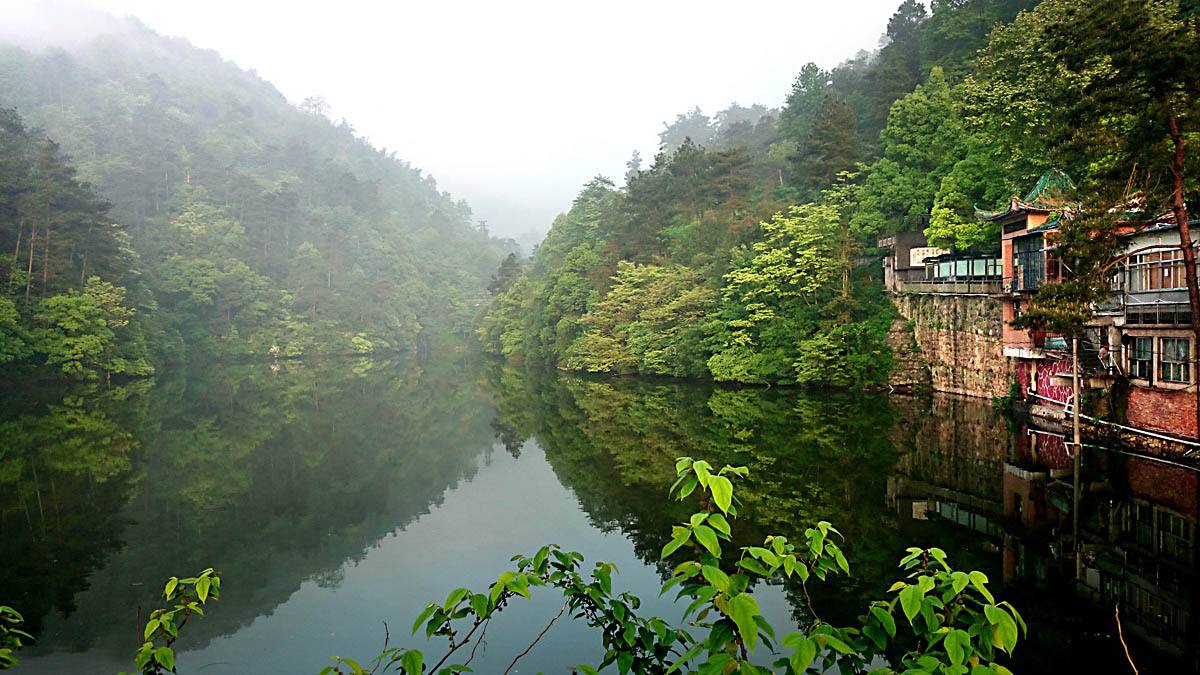
Shaoshan.
Another captivating story is associated with Liuzhao pines in Ciyue An, where locals believe that the trees possess healing properties. It is said that those who sit beneath the pines can gain strength and clarity, echoing the idea of nature as a source of renewal and energy—an integral part of Chinese philosophy.
Nature Meets History
The breathtaking natural scenery of Shaoshan further enhances its allure. The area is home to Yuhu Park, where the tranquil reservoir reflects the blue sky and surrounding emerald hills, creating a serene environment for contemplation. The Eight Sight Screens and the Tiger Resting Ground, both natural formations, are steeped in local legends, offering picturesque views that have inspired poets and artists throughout history.
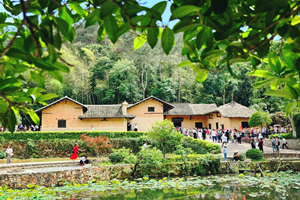
Shaoshan.
Living Tradition
Today, Shaoshan remains a vibrant site of pilgrimage for thousands of visitors each year. The Bronze Statue Square and the Shaoshan Martyrs Cemetery are testament to the ongoing reverence for revolutionary history in China. The square, dominated by the majestic bronze statue of Mao, is a gathering site for visitors, where the legacy of revolutionary fervor is palpably felt.
This blend of history, culture, and natural beauty makes Shaoshan not just a destination but a profound experience. As you traverse its landscapes and engage with its stories, you’ll find that Shaoshan is a living testament to the enduring spirit of its people and their history—a place where legends breathe life into the past.
In conclusion, whether you are drawn by the revolutionary heritage or the enchanting legends, Shaoshan offers a compelling journey through China’s rich historical tapestry, inviting you to explore, reflect, and connect with a defining chapter of modern Chinese history.
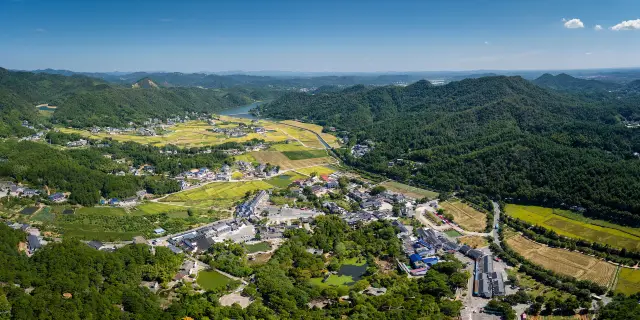
Shaoshan.
Main Highlights: What You Absolutely Can’t Miss
Discover the Unmissable Highlights of Shaoshan
Nestled in Hunan Province, Shaoshan is a treasure trove of cultural and historical significance, primarily known as the birthplace of Chairman Mao Zedong. This enchanting destination offers a unique blend of revolutionary heritage and stunning natural beauty. Here’s a guide to the must-see attractions that capture the essence of Shaoshan.
1. The Former Residence of Mao Zedong
Step into the humble beginnings of one of China’s most influential leaders at the Former Residence of Mao Zedong. This quaint farmhouse, built in traditional southern Chinese style, provides a glimpse into Mao’s early life. The residence, encompassing 566.39 square meters, is surrounded by picturesque hills and water, reflecting the simplicity of rural life in the early 20th century. A visit here is not only an exploration of history but also a way to understand Mao’s formative years and the environment that shaped his ideologies.

Shaoshan.
2. Mao Zedong Memorial Hall
Adjacent to Mao’s ancestral home, the Mao Zedong Memorial Hall is a significant site for commemorating the leader’s life and legacy. Constructed in 1964, this expansive hall displays artifacts, photographs, and exhibits related to Mao’s contributions to China. The memorial hall serves as a poignant reminder of the historical transformations that took place under his leadership and is a must-visit for anyone wanting to delve deeper into modern Chinese history.
3. Mao Family Ancestral Hall
The Mao Family Ancestral Hall, built in the mid-Qing Dynasty, holds deep cultural significance. Established in 1758, this hall is dedicated to the worship of Mao’s ancestors and reflects the traditional values of filial piety and respect for heritage that are central to Chinese culture. Visitors can admire the intricate architecture and learn about the Mao family’s lineage and its impact on Chinese history.
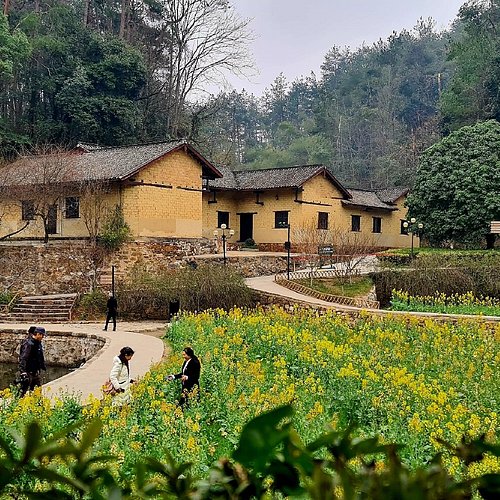
Shaoshan.
4. Bronze Statue Square
At the Bronze Statue Square, you’ll find a striking statue of Mao Zedong that stands as a symbol of his enduring presence in Chinese society. Surrounded by lush gardens, this area is a gathering place for locals and tourists alike, often filled with activities celebrating Chinese revolutionary culture. It’s a great spot to reflect on Mao’s legacy and engage with the vibrant atmosphere of Shaoshan.
5. Water Dripping Cave
For nature enthusiasts, the Water Dripping Cave is a captivating site that combines natural beauty with cultural significance. Located near the scenic Shao Peak, this cave is renowned for its stunning stalactites and tranquil surroundings. Legend has it that Mao Zedong frequently visited this cave for inspiration. The serene environment makes it an ideal location for contemplation and appreciation of nature.

Shaoshan.
6. Former Residence of Peng Dehuai
Explore the life of another iconic figure in Chinese history at the Former Residence of Peng Dehuai, a prominent military leader and a key figure in the Chinese Communist Party. His residence, which reflects the architectural style of the time, provides insights into his life and contributions to the revolutionary movement. It’s a compelling addition to your exploration of Shaoshan’s rich revolutionary history.
7. Yunmen Temple
Immerse yourself in ancient history at Yunmen Temple. This temple, steeped in Buddhist culture, offers a peaceful retreat with its beautiful architecture and serene surroundings. Visitors can enjoy the spiritual ambiance while learning about the temple’s historical significance and its role in the local community.
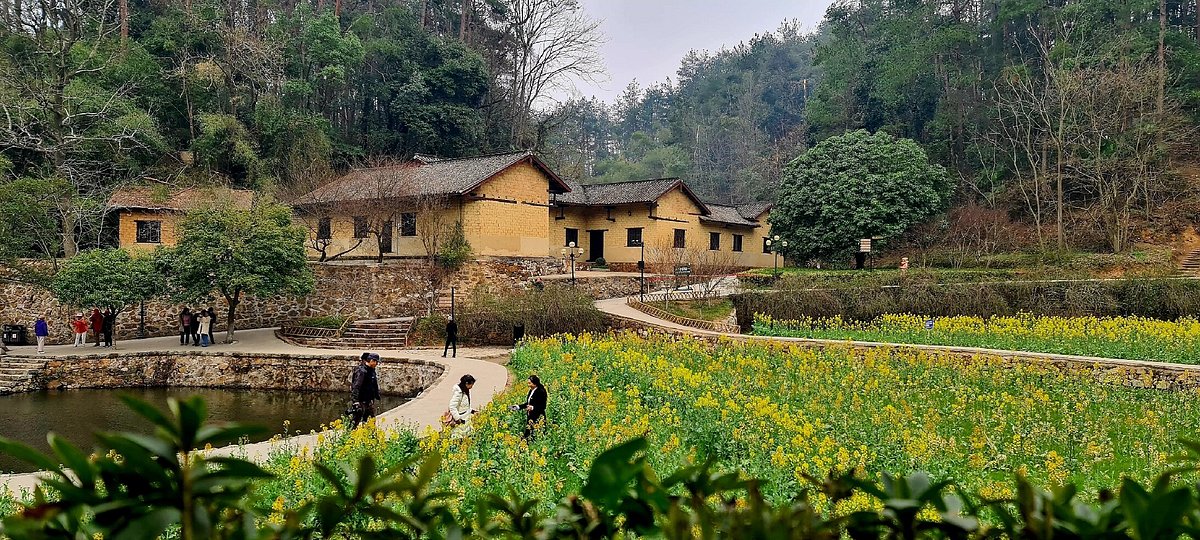
Shaoshan.
8. Shaoshan Martyrs Cemetery
Pay homage to the heroes of the revolution at the Shaoshan Martyrs Cemetery. This solemn site honors those who sacrificed their lives for China’s revolutionary cause. The cemetery is a place of reflection and respect, featuring monuments and inscriptions that tell the stories of bravery and commitment.
9. Natural Scenery and Outdoor Activities
The enchanting landscapes of Shaoshan are not to be missed. The Liuzhao Pines and the surrounding hills offer picturesque views, perfect for hiking and photography. Don’t miss the Black Stone Village and the scenic vistas from the Shao Peak, which are ideal for nature lovers looking to explore the great outdoors.
Conclusion
Shaoshan is more than just a destination; it’s a journey through China’s revolutionary past and a celebration of its cultural heritage. From the historical sites that narrate the story of Chairman Mao to the tranquil natural landscapes, each highlight offers a unique perspective on the rich tapestry of Chinese history. Whether you are a history buff or a nature enthusiast, Shaoshan promises an enriching experience that you will cherish long after your visit.
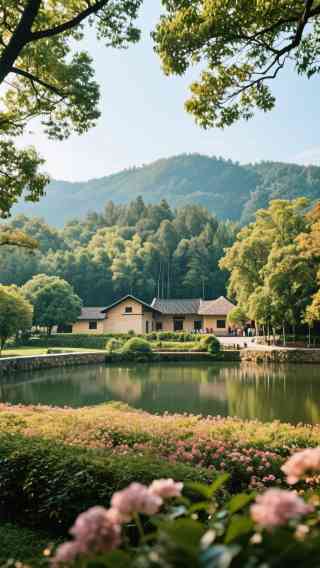
Shaoshan.
Planning Your Visit: A Practical Guide
Essential Information for Visiting Shaoshan
Shaoshan, the birthplace of Chairman Mao Zedong, is a captivating blend of revolutionary history, cultural significance, and natural beauty. As one of China’s key revolutionary memorial sites, it attracts many visitors eager to delve into the legacy of modern Chinese history. Here’s your practical guide to planning a memorable visit to this remarkable destination.
Getting There
Location: Shaoshan is situated in Hunan Province, approximately 100 kilometers from Changsha, the provincial capital.

Shaoshan.
Transportation Options:
– By Air: The nearest airport is Changsha Huanghua International Airport. From there, you can take a taxi or shuttle bus to Shaoshan, which takes about 1.5 hours.
– By Train: High-speed trains from major cities like Beijing and Shanghai to Changsha are frequent. Once in Changsha, you can take a local train or bus to Xiangtan and then a taxi to Shaoshan.
– By Bus: Direct buses from Changsha to Shaoshan are available and provide a cost-effective means to travel.
Best Time to Visit
The ideal times to explore Shaoshan are spring (March to May) and autumn (September to November). During these seasons, the weather is mild and the natural scenery is at its most vibrant. Summers can be hot and humid, while winters may bring chilly temperatures, particularly for outdoor activities.
Key Attractions
-
Former Residence of Mao Zedong
Explore the humble origins of one of China’s most significant figures. This preserved site showcases the life of Mao in a traditional South Chinese farmhouse. -
Mao Zedong Memorial Hall
Located near the Ancestral Hall, this memorial hall offers exhibits detailing Mao’s life and contributions. -
Bronze Statue Square
A striking tribute featuring a towering statue of Mao Zedong, this square is a popular gathering place for visitors and locals alike. -
Water Dripping Cave (滴水洞)
A beautifully scenic area that combines natural beauty with historical significance. The cave is known for its tranquil atmosphere and picturesque surroundings. -
Yunmen Temple
An ancient temple offering insight into the spiritual life of the region. Visitors can appreciate its architecture and serene gardens. -
Shaoshan Martyrs Cemetery
A significant site honoring those who sacrificed their lives for the revolutionary cause, providing a place for reflection.
Cultural Insights
Understanding Red Culture:
Visiting Shaoshan offers a unique opportunity to engage with China’s “Red Culture.” This refers to the revolutionary heritage, especially tied to the Communist Party and figures like Mao Zedong. Be prepared to encounter local veterans and fellow travelers who share a deep reverence for this period.
Local Cuisine:
Don’t miss trying local Hunan cuisine, known for its bold flavors and spiciness. Look for dishes featuring chili peppers, smoked meats, and fresh vegetables.
Practical Tips
- Language: While Mandarin is widely spoken, English may be less common. Learning a few basic Mandarin phrases can enhance your experience.
- Cash vs. Card: While many establishments accept cards, cash is still commonly used. ATMs are available, but it’s advisable to keep some cash on hand for small purchases.
- Accommodations: Options range from budget hostels to mid-range hotels. Booking in advance during peak travel seasons is recommended to secure your stay.
- Respect Local Customs: When visiting memorial sites, maintain a respectful demeanor as these places hold significant emotional weight for many Chinese visitors.
Conclusion
A trip to Shaoshan is not just a journey through scenic landscapes but also a profound exploration of China’s revolutionary history. Whether you’re standing before Mao’s former residence or walking through tranquil parks, each moment offers insights into the past and its continuing influence on contemporary China. With thoughtful preparation, your visit to this remarkable destination will be both enlightening and memorable.
Tickets: Prices, Booking, and Tips
When planning your visit to Shaoshan, the birthplace of Chairman Mao Zedong and a vital landmark of modern Chinese history, it’s essential to understand the ticketing process, prices, and some valuable tips to enhance your experience. Here’s everything you need to know to navigate your visit seamlessly.
Entrance Fees for Major Attractions
Shaoshan is home to numerous sites, each with its own entrance fees. Here’s a breakdown of ticket prices for the top attractions:
- Former Residence of Mao Zedong:
- Price: Free admission
-
Note: Guided tours are available for a nominal fee.
-
Mao Zedong Memorial Hall:
- Price: Free admission
-
Note: Visitors may need to show identification.
-
Mao Family Ancestral Hall:
- Price: Approximately CNY 10 (about $1.50)
-
Note: This hall provides insights into the Mao family’s history.
-
Water Dripping Cave:
- Price: Approximately CNY 30 (about $4.50)
- Note: The cave is known for its natural beauty and unique formations.
Package Deals
For those looking to explore multiple sites, consider a package tour that encompasses various attractions. Some travel agencies offer comprehensive packages that include transportation and guided tours, which can often save you money and streamline your experience.
Booking Information
- Online Reservations: Many sites offer the convenience of online booking, especially during peak tourist seasons. Visit official websites or authorized travel agencies to secure your tickets in advance.
- On-Site Purchasing: Tickets can also be purchased at the entrance of each site. However, be prepared for longer lines during busy times, particularly on weekends and public holidays.
Payment Options
Most attractions accept various payment methods, including cash (Chinese Yuan) and mobile payment apps, such as WeChat Pay and Alipay. Credit cards are not always accepted, so it’s advisable to carry some cash.
Tips for a Smooth Visit
- Arrive Early: To avoid the crowds and fully enjoy each site, plan to arrive early in the day.
- Guided Tours: Consider joining a guided tour to gain deeper insights into the historical significance of the sites. Many guides are knowledgeable about Mao’s life and the events that shaped modern China.
- Weather Preparedness: Check the weather forecast before your visit, as certain attractions, especially outdoor ones, can be affected by rain or extreme heat.
- Respectful Behavior: As many sites in Shaoshan are memorials, maintain a respectful demeanor while visiting, especially in places like the Memorial Hall.
Contact Information for Assistance
Should you need further assistance during your planning or visit, you can reach out to local travel agencies:
- Email: [email protected]
- Phone: +86-28-85223672 / +86 191 3897 0032
By keeping this information in mind, you’ll be well-prepared to explore the rich history and culture that Shaoshan has to offer, making your visit both educational and memorable. Enjoy your journey through this pivotal chapter of Chinese history!
How to Get There: A Complete Transportation Guide
Getting to Shaoshan: Your Transportation Guide
Nestled in the heart of Hunan Province, Shaoshan is a treasure trove of revolutionary history, natural beauty, and cultural significance. Whether you’re a history buff eager to explore the birthplace of Chairman Mao Zedong or a traveler looking to experience the stunning landscapes, reaching Shaoshan is a journey worth undertaking. Here’s how to navigate your way to this remarkable destination.
By Air
The nearest major airport to Shaoshan is Changsha Huanghua International Airport (CSX), located approximately 90 kilometers (about 56 miles) from Shaoshan. This airport serves numerous domestic and international flights, making it a convenient entry point for international travelers.
- From the Airport to Shaoshan:
- Taxi: Direct taxis are available outside the terminal, and the ride to Shaoshan will take around 1.5 hours, depending on traffic. Expect to pay between 200-300 RMB (approximately $30-$45).
- Airport Shuttle: Alternatively, you can take an airport shuttle bus to Changsha South Railway Station and then transfer to a train or bus to Shaoshan.
By Train
Shaoshan is well-connected by rail, making train travel a popular option among visitors.
- From Changsha:
- High-Speed Train: Take a high-speed train from Changsha South Railway Station to Xiangtan Railway Station, which is the nearest major station to Shaoshan. The journey takes about 30 minutes and trains run frequently throughout the day.
-
Transfer to Shaoshan: Upon arrival at Xiangtan Railway Station, you can take a local bus (approximately 1 hour) or a taxi (about 30 minutes) to reach your final destination in Shaoshan.
-
From Other Cities:
- Shaoshan can also be accessed via train from cities such as Wuhan, Zhangjiajie, and Guilin. You’ll typically need to transfer at Xiangtan Railway Station.
By Bus
For those seeking a more budget-friendly route, buses are available from several cities in Hunan Province.
- From Changsha:
-
Buses depart from the Changsha West Bus Station to Shaoshan. The journey takes approximately 1.5 to 2 hours and tickets can be purchased on-site. Expect a fare of around 40 RMB (approximately $6).
-
From Xiangtan:
- Local buses frequently run from Xiangtan, and the journey is quick, taking about 30 minutes.
By Car
For a more personalized experience, consider renting a car or hiring a driver.
- Self-Drive:
-
If you’re comfortable driving in China, you can rent a car at the airport or in Changsha. The drive to Shaoshan is straightforward, primarily via G4 and G106 highways.
-
Private Driver:
- Hiring a private driver is also a convenient choice, allowing you to sit back and enjoy the scenic views of Hunan Province.
Navigating Shaoshan
Once you arrive in Shaoshan, getting around is relatively easy:
- Local Transportation:
-
Taxis and ride-hailing apps like Didi offer convenient transport options within the city. Bicycles can also be rented for those looking to explore at a leisurely pace.
-
Walking:
- Many of the attractions in Shaoshan, such as the Former Residence of Mao Zedong and the Mao Zedong Memorial Hall, are within walking distance of each other, allowing you to soak in the local atmosphere.
Conclusion
Visiting Shaoshan provides a unique glimpse into China’s revolutionary past while allowing travelers to connect with its rich cultural heritage. Whether you choose to fly, train, or drive, the journey to this historical gem is as rewarding as the destination itself. Prepare to be inspired by the stories and landscapes that await you in Shaoshan!
Local Cuisine and Accommodation Nearby
Discovering Shaoshan’s Culinary Delights and Cozy Stays
Shaoshan, a town steeped in revolutionary history and natural beauty, offers not just a glimpse into China’s past but also a delightful array of local cuisine and comfortable accommodations. Whether you’re exploring the legacy of Chairman Mao Zedong or simply soaking in the picturesque landscapes, indulging in the local flavors and finding a perfect place to rest is essential for every traveler.
Local Cuisine
When in Shaoshan, immerse yourself in the rich culinary culture of Hunan Province, known for its bold flavors and spicy dishes. Here are some must-try local delicacies:
-
Hunan Spicy Fish Head (剁椒鱼头): A signature dish, this spicy fish head is stewed with a mix of chopped chili peppers, garlic, and ginger, resulting in a flavorful and aromatic experience.
-
Steamed Pork with Rice Flour (米粉蒸肉): This dish features tender pork steamed with rice flour, creating a unique texture and a savory taste, often enjoyed with a side of pickled vegetables.
-
Hunan Smoked Meat (湘西腊肉): A traditional method of preserving pork, Hunan smoked meat is rich in flavor, usually served with sautéed greens for a balanced meal.
-
Spicy Tofu (剁椒豆腐): Soft tofu paired with a spicy sauce made of chopped peppers and garlic, this dish is a perfect representation of Hunan’s love for spice.
-
Local Noodles (米粉): Hunan-style rice noodles are often served with various toppings, including vegetables, meats, and spicy sauces, making them a hearty and satisfying meal.
Where to Eat
-
Shaoshan Local Cuisine Restaurant (韶山本土餐馆): Located near the Mao Zedong Memorial Hall, this eatery is renowned for its authentic Hunan dishes and welcoming atmosphere.
-
Mao’s Favorite Restaurant (毛氏餐馆): This restaurant pays homage to the town’s most famous resident, offering a menu inspired by Mao’s favorite dishes, all prepared with a modern twist.
-
Xiangtan Street Food Stalls (湘潭小吃摊): For a more casual dining experience, explore the street food stalls near Shaoshan’s main square. You’ll find everything from spicy skewers to steamed buns, perfect for a quick bite on the go.
Comfortable Accommodations
After a day of exploration, retreat to one of Shaoshan’s comfortable accommodations, where you can relax and recharge for another day of adventures:
-
Shaoshan International Hotel (韶山国际酒店): This upscale hotel offers modern amenities, spacious rooms, and stunning views of the surrounding mountains. It’s conveniently located near major attractions, making it an excellent choice for travelers.
-
Hunan Shaoshan Hotel (湖南韶山大酒店): Known for its warm hospitality and clean rooms, this hotel provides a cozy atmosphere at a reasonable price. It’s a great base for exploring the historical sites of Shaoshan.
-
Mao’s Hometown Guesthouse (毛家乡民宿): For a more intimate experience, consider staying at a local guesthouse. This charming accommodation allows you to connect with the local culture while enjoying home-cooked meals and personalized service.
-
GreenTree Inn Shaoshan (如家酒店): A budget-friendly option, this hotel offers comfortable rooms and essential amenities. It’s ideal for travelers looking for a straightforward place to stay without breaking the bank.
Conclusion
Whether you’re sampling the bold and spicy flavors of Hunan cuisine or resting in one of Shaoshan’s inviting accommodations, your experience in this historic town will surely be enriched. Embrace the local culture, indulge in delectable dishes, and enjoy a cozy stay as you explore the profound legacy of Shaoshan.
Frequently Asked Questions
Frequently Asked Questions about Shaoshan
1. What is Shaoshan known for?
Shaoshan is renowned as the birthplace of Mao Zedong, one of the most significant figures in modern Chinese history. It serves as a vital revolutionary memorial site, showcasing a blend of cultural, historical, and natural attractions. Visitors can explore sites such as the Former Residence of Mao Zedong and the Mao Zedong Memorial Hall, while also enjoying the area’s picturesque landscapes.
2. How do I get to Shaoshan?
Shaoshan is conveniently located near Changsha, the capital of Hunan Province. You can reach Shaoshan by taking a high-speed train or bus from Changsha, which takes approximately 30-45 minutes. Additionally, local taxis and ride-sharing services are available for direct transport.
3. What are the must-visit attractions in Shaoshan?
Some of the top attractions include:
– The Former Residence of Mao Zedong: A well-preserved example of a traditional farmer’s house.
– Mao Zedong Memorial Hall: A significant site dedicated to Mao’s life and contributions.
– Bronze Statue Square: An impressive square featuring a statue of Mao Zedong.
– Water Dripping Cave: A stunning natural attraction with unique geological features.
– Yunmen Temple: A historical site reflecting ancient Buddhist architecture.
4. Is there an entrance fee for the attractions?
Most of the revolutionary sites in Shaoshan, including the Former Residence of Mao Zedong and Mao Zedong Memorial Hall, have free admission. However, some specific attractions may charge a nominal fee. It’s advisable to check local listings or inquire at your accommodation for detailed information.
5. What is the best time to visit Shaoshan?
The ideal time to visit Shaoshan is during spring (April to June) and autumn (September to November) when the weather is mild and pleasant. The natural scenery is especially beautiful during these seasons, making it perfect for exploration and photography.
6. Are there guided tours available?
Yes, several local tour operators offer guided tours of Shaoshan. These tours often include transportation, a knowledgeable guide, and visits to key historical sites. Tailor-made tour packages are also available for those interested in a more personalized experience.
7. What cultural etiquette should I be aware of when visiting?
When visiting Shaoshan and its historical sites, it’s respectful to maintain a quiet demeanor, especially in memorial areas. Dress modestly and avoid loud conversations. Additionally, it’s customary to greet locals with a polite nod or smile, showcasing your respect for their culture.
8. Where can I find accommodations in Shaoshan?
Shaoshan offers a range of accommodations, from budget hotels to more luxurious options. Many hotels are located near major attractions, making it convenient for travelers. Booking in advance during peak seasons is recommended to secure your preferred lodging. Check online travel platforms for reviews and availability.
Final Thoughts on Your Trip
As you conclude your journey through Shaoshan, a place steeped in history and cultural significance, it’s clear that this destination offers more than just scenic beauty – it is a profound connection to the very roots of modern China. Here are some reflections to consider as you wrap up your visit:
Embrace the Heritage
Shaoshan is not just the birthplace of Chairman Mao Zedong; it is a symbol of resilience, revolution, and the enduring spirit of the Chinese people. Walking through the Former Residence of Mao Zedong and the Mao Zedong Memorial Hall, you gain insights into the life of a man who shaped the course of history. These sites invite you to reflect on the complexities of change and the narratives that define a nation.
Nature’s Serenity
Beyond its revolutionary landmarks, Shaoshan boasts stunning natural landscapes that provide a tranquil backdrop to your explorations. The Water Dripping Cave and the serene Yuhu Park offer a moment of solace amid your historical discoveries. Take a stroll around the picturesque reservoir, where the interplay of water and sky creates a painterly scene that lingers in your memory.
Connect with Local Culture
Engage with the vibrant local culture, where the spirit of patriotism and reverence for history is palpable. You may encounter old veterans and young pioneers, each with stories that illuminate Shaoshan’s role in China’s past. These interactions deepen your understanding of the Red Culture that thrives here, providing a unique glimpse into the heart of Chinese society.
A Journey of Reflection
As you prepare to leave, take a moment to reflect on the stories, sights, and experiences that have shaped your understanding of this remarkable place. Whether you came to explore its historical significance or to immerse yourself in its natural beauty, Shaoshan promises to leave a lasting impression that resonates long after your departure.
In the end, Shaoshan is not just a destination on your travel itinerary; it is a journey into the depths of history, culture, and the human experience. So carry these memories with you, and let them inspire your future travels throughout China and beyond.